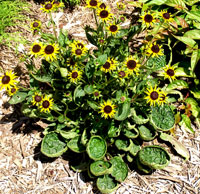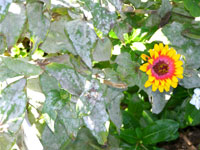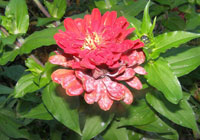Extension > Garden > Diagnose a problem > What's wrong with my plant? > Annuals and Perennials > Marigold > Malformed, cupped or distorted leaves
Marigold > Leaves > Malformed, cupped or distorted leaves
1 of 2
Plant growth regulator herbicide injury
(2, 4-D, Dicamba, etc.)
- Leaves are twisted, cupped, or distorted
- Leaves may appear thick and leathery
- Veins in leaves are thick and close together
- Above ground root formation
- Side of the plant closest to the herbicide application is most severely affected
- Different species of plants in spray area will show similar symptoms
- More information on plant growth regulator herbicide injury
2 of 2
Powdery Mildew
Golovinomyces (syn. Erysiphe) cichoracearum
- Powdery, fluffy white spots and blotches on leaves, stems, and flower parts
- Tiny black round spheres may be visible within white spots late in the season
- Spots typically start on lower leaves but can spread to cover the entire plant
- Severely infected leaves may be completely covered in white or grayish white fungi
- In some cases, leaves become curled or twisted or turn yellow due to the infection
- More information on powdery mildew









